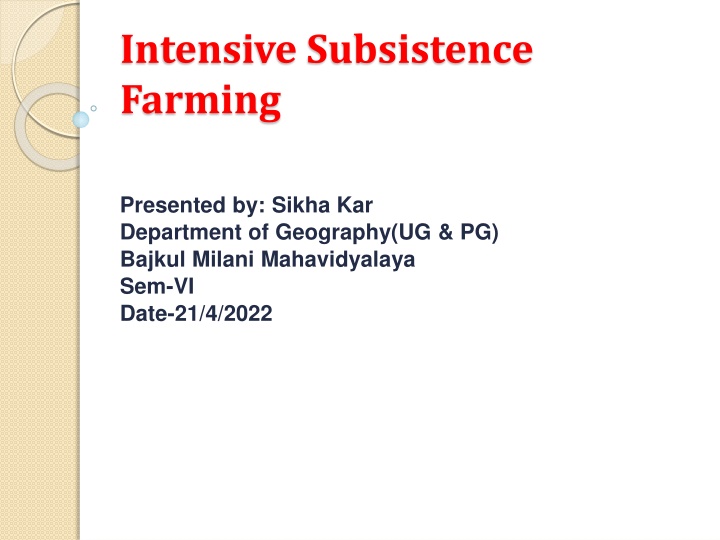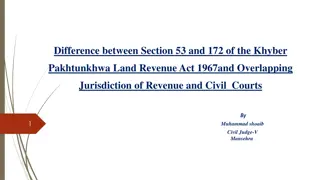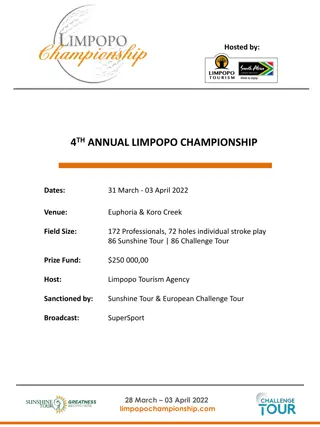
Intensive Subsistence Farming: Characteristics and Significance in Agriculture
Explore the characteristics and significance of intensive subsistence farming, a form of agriculture in Asia known for high output per unit of land. Learn about the evolution, location, and farming practices involved in this distinctive agricultural system.
Download Presentation

Please find below an Image/Link to download the presentation.
The content on the website is provided AS IS for your information and personal use only. It may not be sold, licensed, or shared on other websites without obtaining consent from the author. If you encounter any issues during the download, it is possible that the publisher has removed the file from their server.
You are allowed to download the files provided on this website for personal or commercial use, subject to the condition that they are used lawfully. All files are the property of their respective owners.
The content on the website is provided AS IS for your information and personal use only. It may not be sold, licensed, or shared on other websites without obtaining consent from the author.
E N D
Presentation Transcript
Intensive Subsistence Farming Presented by: Sikha Kar Department of Geography(UG & PG) Bajkul Milani Mahavidyalaya Sem-VI Date-21/4/2022
Intensive Subsistence Farming: The term, intensive subsistence agriculture' is used to describe a type of agriculture characterized by high output per unit of land and relatively low output per worker. Although the nature of this agriculture has changed and in many areas now it is no more subsistence. But despite changes the term intensive subsistence' is still used today to describe those agricultural systems which are clearly more sophisticated than the primitive agriculture. Sometimes it is also known as monsoon type of agriculture'. Location: This form of agriculture is best developed in and practically confined to the monsoon lands of Asia. It is found in China, Japan, Korea, India, Pakistan, Sri Lanka, the greater part of continental South-East Asia and parts of insular South-East Asia (Java, Luzon, Visayan Inlands, coastal Sumatra and Malaysia)
Farming in both the wet lowlands and the terraced uplands has to be very intensive to support a dense population. Population densities in some agricultural areas in Asia are higher than those of industrial areas in the West. Many of the regions of intensive subsistence farming have a highly developed form of society and government and some such as China and India have a continuous history of civilization going back more than 4,000 years. The fast-growing population, almost unchecked for centuries, necessitates an ever greater intensity in the tillage of the lands. A small plot of land has to support 5 or 10 times the number of people that a similar plot on an extensive corn farm in the USA could feed
Characteristics: The main characteristics of the intensive subsistence agriculture are as follows: (i) Very small holdings: Farms have been subdivided through many generations so they have become extremely small and often uneconomic to run. An average farm in Japan is approximately 0.6 hectare (about 1.5 acres) but in India and elsewhere in Asia farms may be even smaller. Individual peasants grow crops mainly to support their own families, though there is some surplus for sale in some areas. In China, however, rapid agricultural changes took place after the agrarian revolution of 1949 when the tiny farms were consolidated, under communist rule, into large collectives. (ii) Farming is very intensive: In Monsoon Asia, the peasants are so land hungry' that every bit of tillable land is utilized for agriculture. The fields are separated only by narrow, handmade ridges and footpaths by which the farmers move around their farms. These are kept very narrow to save space. Additional land is made available for cultivation by draining swampy areas, irrigating drier areas and terracing hill slopes to produce flat areas that are suitable for padi cultivation. Only the steepest hills and the most infertile areas, irrigating drier areas and terracing hill slopes to produce flat areas that are suitable for paddy cultivation. Only the steepest hills and the most infertile areas are left uncultivated. Farming is so intensive that double- or treble- cropping is practiced, that is, several crops are grown on the same land during the course of a year. Where only one crop of padi can be raised, the fields are normally used in the dry season to raise other food or cash crops such as sugar, tobacco or oil-seeds.
(iii) Much hand labor is entailed: Traditionally, much hand labor is required in wet padi cultivation. Ploughing is done with the aid of buffaloes, the fields are raked by hand, the padi is planted painstakingly in precise rows by the women, harvesting is done with sickles and threshing is done by hand. Farm implements are often still very simple. The basic tools are simple ploughs, the cangkul, a kind of spade, and hoes. Nowadays machinery has been developed which is capable of working in the flooded fields and separate machines can plough, plant and harvest the padi. Such machines are not yet widely used because most farmers cannot afford to buy them, but they are extensively used in more affluent Japan and are gradually spreading throughout Monsoon Asia. They may be owned by firms or co-operatives and hired by individual farmers. Machinery has also been widely used in the state farms of China. (iv)Use of animal and plant manures: To ensure high yields and continued fertility farmers make use of every available type of manure including farm wastes, rotten vegetables, clippings, fish wastes, guano, animal dung (especially those from the pig sties and poultry yards) and human excreta.
Increasing amounts of artificial fertilisers are now being used in Japan, India and China, usually with government advice or assistance. The basic fertilisers applied include phosphates, nitrates and potash, which help to replenish vital plant nutrients in the soil. (v)Dominance of padi and other food crops: Padi is the most dominating crop produced in intensive subsistence agriculture. But due to differences in relief, climate, soil and other geographical factors, it is not practicable to grow padi in many parts of Monsoon Asia. Though methods are equally intensive and farming is done on a subsistence basis, a very wide range of other crops are raised. In most parts of North China, Manchuria, North Korea, northern Japan and Punjab, wheat, soya beans, barley or kaoliang (a type of millet) are extensively grown as major food crops. In the India Deccan and parts of the Indus basin sorghum or millet is the dominant crop due to the scarcity of rain and the poorer soils. In many parts of continental South-East Asia such as the Dry Zone of Myanmar, the Korat Plateau of Thailand and the interior regions of Indo-China, the annual precipitation is too low for wet padi cultivation, and the substitute crops are millet, maize and groundnuts grown together with cotton, sugarcane and oil-seeds. During recent decades, this type of agriculture has registered a significant improvement in the form of mechanisation, use of improved seeds and fertilisers and other modern systems of agroscience. The countries like China, India, Japan, Malaysia, Korea, Taiwan, Philippines, etc.,have adopted improved system of agriculture
The intensity of agriculture and multiple cropping are directly governed by the pressure of population in a given region at a given point of time. In shifting cultivation tracts where the density of population per square kilometer is generally less than ten persons, the intensity of agriculture is very low. The land is such areas are sown only once in a year and that too abandoned after one or two years. But in those parts where density of population is relatively high, at least two crops in a year is the usual practice and the same piece of land is shown season after season and generation after generation. Intensive subsistence agriculture is best developed and practically confined to the monsoon lands of Asia. It is carried on mainly in China, Japan, India, Bangladesh, Myanmar (Burma), Thailand, Sri Lanka, Malaysia, Philippines. Indonesia, Laos, Cambodia and the islands of Pacific Ocean, Indian Ocean and Southeast Asia. These are the most densely populated parts sustaining about two-third population of the world. In these countries, the density of population is higher than that of the industrial countries of Europe and America. The fast growing population, almost unchecked for centuries, necessitates an even greater intensity in the village of land. Farming in both the wet low lands and the terraced uplands is, therefore very intensive to support the dense population of teeming million. There are two types of the intensive subsistence agriculture. One is dominated by wet paddy and the other is dominated by crops other than paddy, e.g., wheat, pulses, maize, millets. sorghum, soya-beans, tubers and vegetables.




















